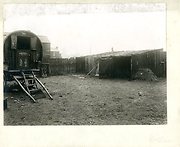 Hartlepool Sports & Leisure
Hartlepool Sports & Leisure
- Cinemas, Theatres & Dance Halls
- Musicians & Bands
- At the Seaside
- Parks & Gardens
- Caravans & Camping
- Sport
 Hartlepool Transport
Hartlepool Transport
- Airfields & Aircraft
- Railways
- Buses & Commercial Vehicles
- Cars & Motorbikes
- The Ferry
- Horse drawn vehicles
 A Potted History Of Hartlepool
A Potted History Of Hartlepool
- Unidentified images
- Sources of information
- Archaeology & Ancient History
- Local Government
- Printed Notices & Papers
- Aerial Photographs
- Events, Visitors & VIPs
 Hartlepool Trade & Industry
Hartlepool Trade & Industry
- Trade Fairs
- Local businesses
- Iron & Steel
- Shops & Shopping
- Fishing industry
- Farming & Rural Landscape
- Pubs, Clubs & Hotels
 Hartlepool Health & Education
Hartlepool Health & Education
- Schools & Colleges
- Hospitals & Workhouses
- Public Health & Utilities
- Ambulance Service
- Police Services
- Fire Services
 Hartlepool People
Hartlepool People
 Hartlepool Places
Hartlepool Places
 Hartlepool at War
Hartlepool at War
 Hartlepool Ships & Shipping
Hartlepool Ships & Shipping

Wagga
Details about Wagga
'Wagga' was a local nickname for the area officially called Longhill. It was an area originally built by Thomas Richardson to the west of his steelworks comprising Florence Street, Hill Street and Portland Street and these remote streets, named after the Australian Wagga Wagga, were remote from the rest of the town and without drainage or paving. The whole area around Sydenham Road eventually was given this nickname.
Location
Related items :
 Booth's Grocery Store
Booth's Grocery Store
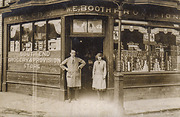 Donated by Dorothy Warburton
Donated by Dorothy WarburtonEwart Booth in front of his grocery and provision store which was in King Street, Hartlepool, an area known as the 'Wagga'. The lady in the picture was his assistant and was known as 'Miss Fawcett'.
Locals called the store Boothies
More detail » Florence Street- Mary Anne Storey Hughes
Florence Street- Mary Anne Storey Hughes
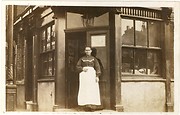 Donated by Linda Hughes Hiser
Donated by Linda Hughes HiserTaken from Hughes corner shop at 70 Florence Street in the early 1900s, the image shows Mary Ann Hughes who married George Henry Hughes. The shop was still open until, along with the other two Wagga streets, Florence Street was demolished.
This photo is from an American lady, Linda Hughes Hiser, who has done a lot of family research and also luckily has ancestors who kept photos !
To read more about the family and Linda's research about her Hartlepool branch, follow this link.
http://lindahiser.com/Hughes.html
More detail »
 Gypsies at Longhill (1)
Gypsies at Longhill (1)
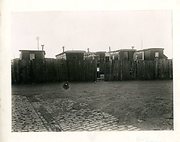 Part of the Hartlepool Museum Service collection
Part of the Hartlepool Museum Service collectionTaken in the Winter Street / Sydenham Road area in 'Wagga'
More detail » Gypsies at Longhill (2)
Gypsies at Longhill (2)
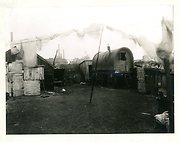 Part of the Hartlepool Museum Service collection
Part of the Hartlepool Museum Service collectionTaken in the Winter Street/ Sydenham Road area. The gypsy children would briefly attend St Aidan's School Longhill.
The main gypsy families are listed in 'Beneath the Wagga Moon' 1998 which is in Hartlepool Library.
More detail » Longhill 1959
Longhill 1959
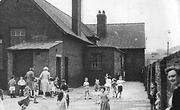 Donated by Frances Wilson
Donated by Frances WilsonDated 1959
Taken around 1959, the picture shows the playground of St Aidan's Infant School Longhill. On the right wearing glasses is the headmistress Miss Molly Pattison who later went on to Oxford Street School.The other two adults are Reta Campbell and Jean Bluckert. Behind the wall on the right was Windermere Road and behind the school were the Steelworks cooling towers. Just out of sight is Seaton High Light which has now been moved to the Marina.
The infants' school moved to St Aidan's Loyalty Road in 1960-1.
More detail » Memories of Empire Day and Wagga Fair
Memories of Empire Day and Wagga Fair
Empire Day
On the whole, I liked going to that school. The teachers that come to mind were Mr. Taylor, headmaster, who loved conducting the whole school singing the patriotic songs for Empire Day – “Land of Hope and Glory” was one; Mr. Fuller; ‘Daddy’ Burns, who was Father Christmas every year; ‘Pa’ Cuby, my favourite; and ‘Ma’ Bulmer, who played the piano as necessary, for marching round the hall, or hymns at prayer and singing songs – I think she enjoyed doing it.
Then the most impressive building in Belle Vue next to the school was, of course, St. Aidan’s Church. I was a probationer choirboy there, and Freddie Hall was the choirmaster. I remember an incident at the church – prior to being a choirboy, I must emphasise; going with a few more boys one Sunday night for the service, we were all ejected by an irate verger for flicking little glass stink bombs around the pews.
Crossing from the church on the last Oxford Street corner that ended at Stockton Road was Frank Rogers’ sweet and tobacco shop. It was only a small corner shop then, and belonged to the father of Councillor Rogers. Close to him on the same block, as you once more re-track in the South Parade direction, was Ferry’s the chemist. Ferry’s was on Northumberland Street corner, and on the other was a pawn shop, which was well patronised in those days.
Next door you came to Joyce’s the wet fish shop, then Stokes, noted for their fourpenny meat pies and one or two other goodies, including sweets. The most popular seemed to be the Garnett’s toffee – a wrapped lump bought for a ‘ha’penny’. Inside the wrapper was a printed strip with the name of a position in a football side – centre forward, left back, and so forth. The list included two linesmen and they were the scarcest. Once‘gotten’ you were ‘made’. After collecting the set and returning them to the shop, a block of toffee in palatable squares was given free in exchange.
Next to Stokes’ on the other corner of Oxford Street was a little shop, but I cannot bring to mind what its wares were. Then, I think, came Stockdale’s newspaper shop and a gents’ hairdresser, followed by a boot and shoe shop, with poles outside draped with boots for display. Lightfoot was the name I believe, and he was partially, or totally blind.
Lastly came St. Aidan’s Hall on the next block, ironically close to the off-licence. Church dances were held there, besides the usual functions, and they always had a Christmas ‘do’ of some kind, when all the children got an orange and a penny from around the Christmas Tree.
Up the side street from Dyer’s off-licence was a house where you could buy home-made treacle toffee in round cake papers and toffee apples – very nice.
So, on the whole, Oxford Street was a compact, shopping high street that met the needs of the community for clothing, eating and drinking, and on that note I close the description of Belle Vue Way and of the good, old bad days. But Belle Vue itself had other ways of life that have never been erased from my memory.
Heroes of Wagga
In Wagga, for instance, Jo’s football team, from St. Joseph’s Catholic School seemed to win the school cup every year. I think they paraded their heroes around their neighbourhood with some sort of jazz band playing tunes with what they called ‘tin submarines’. They were shaped that way, one end a flat mouthpiece and the middle raised up like a conning tower, which was unscrewed to replace paper on a round wire mesh. When you sang your tune through it, the result was the same as singing with paper and hair comb.
The South Durham Steel Works was the main bread winner in those days. It was the main source of pollution as well! The wind off the sea brought red ore dust drifting over roof tops and settling on the paintwork, and in the rooms if the windows were open. You also got the sooty smoke from a massive smoke stack when it discharged and then, for good measure there could be gassy fumes.
I had often laid in bed being wakened by the early morning shift steelworkers, some going to, and others, finished, leaving from work. There was a sharp plop and clang from their wooden-soled clogs, leather topped, and edged with steel strip sole and heel. These were the chaps who worked in the sheet mill. One man pushed a white hot thick plate, probably two foot long by about ten inches wide, into large steel rollers with long tongs, and another man with tongs deftly got a grip with them and heaved over the plate to the fellow on the other side, and kept doing that whilst another man on either side of the rollers turned the ‘screw’ down till they had a long piece of sheet steel rolled to the right gauge. Hence the wearing of clogs; the hot ground and retreating and going forward as the sheet got longer – this tough footwear was essential. On a still night, the boom and the simultaneous ring of the steel from the rollers echoed for miles around.
An uncle of mine, a steelworker, used to give me some coppers at the weekend when he was on 6 am till 2 pm shift if I took his breakfast for 8 am before I went to school. When the 8 am till 5 pm workers were finished, it was a common sight to see children waiting at the bottom of the Newburn footbridge in Greatham Street, greeting the men with a call of, “anything left, mister?” hoping there’d be something left in their tommy tins which most workers used for taking meals to work together with a can with a lid for tea. The entrance to the Expansion Works was also at the foot of the bridge, which was also convenient for the same practice.
Whilst in Greatham Street, I would like to mention the steelworks site, called, or nicknamed, ‘the Diamond Field’. Bordered partially by Greatham Street and the full length of Baltic Street it was a sort of tip. A massive heap of red iron ore dominated the site. I believe boiler cinder ash was also dumped there because during the general strike, when no coal was available, the people of Belle Vue visited it with buckets and spades or packs, anything that would hold the cinders or bits of coal for which they foraged to help keep a bit of fire going at home.
Turning round from Baltic Street was Sydenham Road. I think there was a pawn shop about where it started, with some more miscellaneous shops here and there as you went along. Then one reached Kendal Road, just past the end of Studley Road on the left-hand side. There was a large field there, now built on – Kendal Estate is its present name. Every year, in the summer, it was the site for the fair.
The Annual Summer Fair
My first, and worst, memory on that show ground was the ‘Tilt-a-whirl’; like a covered-in roundabout, it was a good way off the ground and perched on the top of a spindle. It had long seats pointing to the middle and you had to climb a flight of steps for entry. When everyone was seated, it started to rotate faster and faster, and when it reached top speed it would suddenly tilt over, giving me nausea, first diving to the ground and zooming up the sky seemingly. I finished the ride handing round the middle pole, feeling very bilious.
Very often, the great attraction would be ‘Peg-leg Peggy’, a one-legged diver, who would slowly hoist himself up ladders, one step at a time, to a very high platform. Watching him ascending gradually brought the tension to a climax when he stood on the platform edge, looking down until he was satisfied everything was OK. Then the crowd would gasp and murmur as he took his high dive down into a tank of water, lined with tarpaulin. With a mighty splash he’d enter the water on his near side and appear on the other, with helpers ready to support him. To me there was no doubt that a mistake could cost him serious injury or his life.
Another high diver was Powsey, and his act was called ‘Powsey’s last dive’. At a time given in advertisements he would climb the same sort of set-up as ‘Peg-leg’, but made it more spectacular by soaking his clothing with inflammable material and diving into flames. A very carefully worked out act, I would say.
Going westwards from Kendall Road to Brenda Road and crossing the same, there was Ashgrove Avenue, with the Belle Vue Congregational Chapel that is still there. I attended it after leaving St. Aidan’s as I didn’t like church. A better thing couldn’t have happened to me. It lifted me from a depressing environment of poverty to a life that gave more hope and inspiration. Everybody seemed to want to help you, and seemed happy to do it. A Mrs. Jolly, an apt name if I may say so, delighted in getting children on concerts and dressing them up in costumes, even using coloured crepe paper if money was hard to come by for some. Mr. Yates was the organist and Mr. Wright looked after a lot of the business for the chapel. My Sunday School teacher, Mr. Billy Braithwaite, was, to me, a great chap; he pointed the way for me to a new life which had more purpose and meaning.
My schooldays up to the age of 12 were at Oxford Street School; after that there was a sorting out with exams that decided whether you went to Elwick Road School or Lister Street School. On the whole, I thought that my experience with Oxford Street School was of mixed feelings. We were taught sportsmanship, integrity, religion and all things that mattered, to help us try to be honest citizens of the future.
The difficult times everybody was going through in those days made ideals seem doubtful, but I think that generation came out in good stead. The things I remember at school that made me sad, were the lads who were even worse off than I was. Some mornings, before lessons started, the teachers had to inspect the pupils. We were lined up in front of the classroom and looked over to see if our shoes and hair were brushed, and our faces, hands and knees, washed, even checking for dirt left in our ears. Of course, the unfortunate, neglected ones suffered every time, and were caned. They had to attend school or the ‘school bobby’ – a name for the school official who called at the homes of children who were absent – would press their parents to make sure they attended ‘or else’. Only genuine illness excused them.
Some of the kids must have lived in hovels, and most of their parents were probably spending what money was available on drink. It was a common sight to see children barefooted, raggy and dirty, in some cases half-starved and with no resistance to the pestilence of ‘nits’, ringworm, scabby skins and the usual measles, chicken pox etc. You’d often see some outside the pubs, waiting for their parents to come and take them home at closing time.
The school has now been pulled down, along with the ‘Long Back’. Taking with it, in my opinion, the main characteristics of Belle Vue as I remember it. In spite of the misery I, and a lot more, endured then, the good things, though few, enlightened me and prepared me to tackle life in a more down to earth sort of way.
Hartlepool Symphony Orchestra
I played the violin and had some experience playing in small groups in the odd dance-hall etc. Anyway, somewhere around 1936 I got an invitation to practice with the symphony orchestra.
We arranged a concert in 1937/38, which was their fifteenth season, covering twenty nine concerts. A vocalist called Fred McIntyre, the conductor, George W. Pearson, and the pianist, Clive M. Lambert, were the main artistes on the programme. This was to be their last concert, as the 1939 World War was imminent. I think admission was about three shillings and sixpence. It was an exciting experience for my girlfriend and future wife, Olga, and myself, wearing a dickey-bow!
When war came, our headquarters in Musgrave Street were damaged, and music and other essentials lost – so that finished everything. I’d like to see a revival of the symphony orchestra, but nothing seems on the cards at the moment.
More detail » Memories of Wagga
Memories of Wagga
Memories of Wagga.
The Belle Vue Way : 1920s – 1930s by Eric Williams
This is a record of Belle Vue as I knew it as a child and a teenager. It is now losing its identity and I thought it would be a good idea to jot down all that I can remember about the area while passing the time away through these long winter nights when television has little to offer in the way of entertainment.
Starting with Oxford Street, from Baltic Street to St. Aidan’s Church, I’ve always thought how unique that street was for its content and service to the local inhabitants.
At Baltic Street end, looking towards St. Aidan’s , on the left hand corner was the Paragon Works. They made whitening powder for a water-mix to do ceilings, etc., and I believe they packed salt as well, employing girls mainly.
As I write on, I must stress I am open to contradiction if any facts are not strictly correct, it being nearly fifty years ago.
Next to the Paragon Works was a knacker’s yard owned, I think, by someone called Herring. It was a common sight to me seeing a two- wheeled cart pulled by a horse, with a dead horse laid along it, covered with tarpaulins.
On the other corner was a tallow factory owned, I think, by C.W.S., which, at times, emitted an awful, sickening stench. They made candles and I saw some greenish in colour, tied by their wicks in bunches. I vaguely remember that somewhere further along from the knacker’s yard was a black, boarded building with double doors that would accept a flat horse and cart, and a strange sort of character with white hair and a flowing beard, always with a cap, and wearing a dark coat, tied at the waist with rope. I think the horse was white and all I remember on the cart was what looked like a large tank with a brass top and a large funnel – this I understand was for the paraffin the tank contained, for distribution to his customers.
What I think adjoined his premises next door was a blacksmith named Greenhow. Then a back street that was shared with Clarendon Road, with a reputation as far as schoolboys were concerned, of having the best ‘gang’ in Belle Vue! Even having the ‘edge’ on the tough lads in ‘Wagga’ who presided on the southern side of Sydenham Road at the end of Clarendon Road.
Then over the road from Greenhow’s, still in Oxford Street was William Brown’s Sawmill. It seemed to thrive in those days with a regular shrieking of cut timber. I remember a fire there, very spectacular at its peak early on in the morning, because it was the drying shed with stacked timber, and the gable end faced the street. It was throwing out terrific heat, so much so that my family and some others who lived close by in Beechwood Road, next to Clarendon Road, were knocked up by firemen and told to get out of doors for safety. There was a bit of panic, and I had only a coat over my night clothes. Anyway, it passed by without further trouble, except that I contracted colic later that day through a chill on the stomach.
Right opposite to that drying shed was Smith’s the sweet shop. When I was lucky and had a ‘ha’penny’ to spend there was the choice of a bar of chocolate (small), Dolly mixtures, lucky potato that had a shiny charm embedded in the nougat dipped in cocoa, or five toffee caramels to name just a few.
At Christmas there was a large net bag full of seasonal lucky dips, all wrapped in coloured ‘tishy’ paper. In two of them that I remember, one had a coloured tin bird surrounded by a tin ring that spun round a twisted metal stem when forced up with a metal sleeve, giving the impression of being in a pretty cage, and the other had the same mechanism but spun a metal propeller off the end of the stem and into the air which drifted a ‘canny’ way before being grounded.
On the same side as Smith’s, after crossing over Beechwood Road end, was Walburn’s shop, a general dealers, I believe. The woman in there was, to me, very reticent. I think she was a widow and my picture of her was of her being rather solemn with a very pale face, and wearing a ‘mop’ cap, dark, with a crinkly elastic edge, a black, long sleeved cardigan, and a floor length skirt to match.
From there, one comes to the ‘Long Back’. This has gone now, being demolished to put what is now the Belle Vue carriageway in its place. Actually it was Studley Road back street. Studley Road was in three sections, starting from Bourne Road to Russell Street, Russell Street to Oxford Street, and Oxford Street to Sydenham Road. The last section backed on to Beechwood Road, east side, the other two backed on to the timber or ‘prop’ field, still the east side, which adjoined Brown’s Sawmill.
That was the ‘Long Back’. It was well used by the eastern side of Belle Vue residents, night and day. The reason being it was the nearest way to get home if they had been to first or second house pictures, or ‘down town’, where Hartlepudlians did their main shopping along Musgrave Street and round to Lynn Street.
I’m almost sure the nearest public house was the Bourne Hotel, located on South Bourne Terrace and Stockton Road junction. I should imagine that would also be well patronised by Belle Vue dwellers.
The comings and goings of the ‘Long Back’ stick strongly in my memory. There was no lighting, and the enclosure round the prop yard and into Oxford Street towards Brown’s Sawmills had a fence made of railway sleepers, topped with slabwood, making it quite high and very dark at night. Where Russell Street divided the back street was the only relief for some light which was faintly reflected from a gas lamp in Studley Road. In the winter nights lads would ‘dare’ each other to run through it, or go shouting after the drunks who often came staggering home along it. Or play ‘kissing catch’, the procedure being that the girls would get a few seconds’ start running off into the back street and then the boys would chase them. If and when a boy caught a girl he got a kiss and would then leave her and run after another girl. It was a bit of fun and kept your circulation going.
On Guy Fawkes night, and for quite a few nights before that as fireworks were on sale early, lads sometimes ran up the back street throwing ‘bangers’ into the dustbins, which were long square metal boxes covered with wooden doors for pulling out to empty, and ‘bangers’ those days made your ears ring.
Whilst on the subject of bonfire night, over the road from Walburn’s shop on the corner of the ‘Long Back’ was Joe Knowles’ shop. He was a newsagent and later on his son carried on the business. It seemed that after he shut his shop on November 5th, he took all his unsold stock of fireworks over to his house, lit a bonfire in his garden and gave the most spectacular fireworks display you would ever see in Belle Vue. They were mainly the flash bombs – a bang when they went off, and another when they’d rocketed up in the sky with a splash of coloured stars.
There was competition with another newsagent in Oxford Street called Stockdale and his shop was four or five streets further up towards Stockton Street. The ‘paper lads’ would wait outside Knowles at tea time during the week, excluding Sundays, looking out all the time up the back street, watching for the papers that were being brought for them by an older lad who had a bicycle. Having a bicycle then had some prestige, being a luxury. He’d bring the newspapers from the ‘Mail Office’ in a mail bag over his shoulders packed tight, and with the surplus laid on the handlebars he’d pedal as fast as possible under the load all the lads would shout him home and he’d jump off and count the papers in so many dozens as were allocated to each one; and off they would run to their own territory for selling and delivery, hoping to get one over the rival camp.
The ‘Long Back’ was a short cut to the slaughter house, as was Studley Road, to a drover. I don’t know where he brought his small herds of cattle and flocks of sheep from, but it was a common sight once or twice a week to see him coming from Sydenham Road end, carrying a stout stick, with a collie dog in attendance. It was fascinating to me watching them both at work, stopping the odd one or two from straying from the others. One of the drovers was nicknamed ‘The Mad Shepherd’ and I think it was he who caused great distress to myself and some other children. One day, I was told, when for some reason a sheep had panicked and tried to jump the ‘prop’ field fence, then fell and broke its neck, the drover promptly cut its throat, letting the blood run down the back street gutter into a grate.
The next corner to Knowles’ shop was one of four shops on each corner of Studley Road, called Relton’s and it was a general dealer, something like Lipton’s type of shop, where you could buy seed cake, bacon, corned beef, vegetables etc . A popular buy was ‘two penn’orth for the pot – a mixture of turnips, leeks, onions or whatever. You just got ‘pot luck’ on what you received (a good caption) as they just gave you what wasn’t being sold quickly enough. Of course, those were the ‘good old days’! Only if people were working. I’ve always called them the bad old days!
Public Assistance
My father was on public assistance, which was very meagre. Most people couldn’t pay their rates and even the most respectable people were fined and made to pay them weekly. I used to ask the lucky women in my neighbourhood whose menfolk had the rare distinction of being in work, if I could do their messages for shopping, just to get the odd coppers which I spent on something to eat. Sometimes I bought one or two eggs to fry, or a ha’porth of pressed dates, figs or cake from Relton’s.
From Relton’s, still on the east side of Studley Road corner, was the pie-and-pea shop where you went with a dish or anything suitable that would hold the pie and peas with gravy. Prior to that it had been a men’s barber shop: kids called it a ‘tu’penny all off’ simply because you didn’t go till you could afford it, and shame made you go when it grew too long. When you came out, you were the original ‘skinhead’ with a tuft left on the front.
Crossing to the west corner direct was Skinner’s bakery and sweet shop. She was a pleasant woman and made lovely home-made bread and cakes. I’ve never forgotten that smell of home-baked bread on entering the shop at times, and of mouth-watering cakes. She sold only a small quota of sweets. ‘Soda lunches’ I remember well: four small, orangey, round, candy sweets, a short liquorice tube and small packet of ‘kali’ of sherbet, which fizzed in your mouth when sucked through the tube.
One oddment I remember her selling was advertised with a cord in the box, showing an old person in a comic cartoon character, jumping up in the air with fright, knees up, hat flying off, walking stick thrown up, eyes popping, almost suggesting what could be done with these little bomber things. They consisted of two small half-round, stony things, which must have had a toy gunpowder cap in between, with paper twisted round them which, if thrown behind somebody, supposedly cracked behind them. They didn’t appeal to me.
On the fourth corner of Studley Road was Atkinson’s the cobbler’s shop, and it was a noisy one when he was trimming and polishing all the boots and shoes. There were two or three shafts driven by a belt on pulleys, with an assortment of grinding, buffing or polishing wheels. There was a proper shouting match when this was happening and customers wanted attention.
Moving further westward on the same side, past Atkinson’s back street, was the Belle Vue Post Office, only small but it served its purpose. After being served, if you wished, you could pass through it by an adjoining door into Handley’s millinery shop. You could buy clothing, curtains and various miscellaneous items. But to me, the toy window set out for Christmas will always be unforgettable. These toys – donkey boilers, dolls, meccano sets, to name just a few – would be sold mainly to the better-off. I, being one of the poor, could only look longingly at them, but it manifested into a dreamland. I think the worst Christmas was getting just an apple and orange, some nuts and a penny in my stocking, but at the same time, it was appreciated. Although so young, I instinctively knew the score.
Still on Handley’s side, which brought us to South Parade, on the next corner was the fish and chip shop – Stafford’s or somebody’s – and a ‘tu’penny fish and a penn’orth’ was the order of the day. I believe beef dripping was used for frying in those days, giving the food a distinct flavour, in contrast to present day frying. The fat was boiled up with a coal fire which needed regular attention with a small shovel and poker.
Crossing Oxford Street from there, was the other half of South Parade, ending at Sydenham Road. Opposite Handley’s was the chapel and over from the fish shop was a butcher’s shop and a tobacconist and backing them in South Parade was a small dance hall, big enough for a jig for the locals.
Keeping on that same side of Oxford Street you came to a storing place for Dyer’s off-licence right opposite, then you crossed a side street, on the corner of which was the Co-operative Stores, with their own bread and cake shop adjoining them in that same side street, and a butcher’s belonging to them next to the grocery in Oxford Street. When poverty was still rife in my family, I remember going into the Co-op for two ‘penn’orth’ of ‘fat pieces’. These were the shavers off the sides of bacon when they were put in the slicing machine. When you got them home, the leanish pieces were put on one side for sandwiches, and the fatty bits rendered down for dip and bread, which tasted much better than margarine, which tasted like soap to me.
The best margarine was ‘Silver Label’, and every half pound had a silvery band round it. After you had collected so many of them and took them back, you got a free block of bitter chocolate wrapped in blue silver paper, which I thought was very nice to eat.
The butchery next door was where I called once a week for a quarter of pie meat for a family dinner for five, and two ‘penn’orth’ of beef bones to boil and make soup.
The next shop was Freddie Gents, mainly a fruiterer but also selling other odds and ends, and a ‘ha’porth’ of bruised fruit was a regular request from school kids. If you won a race on sports day, I think you got a voucher to spend there for pencil cases and pocket knives, etc., from the Oxford Street school which was situated on the next block.
More detail » St Aidan's Infants, Longhill 1952
St Aidan's Infants, Longhill 1952
 Donated by Christine Fox
Donated by Christine FoxDated 1952
St Aidan's Infants, Longhill 1952.
Known faces are : 7th from left back row Alfie Walsh.
Middle: ?, ?,Harold Hatley, Veronica Bennett, Paula Nash, Linda Braham, Ivor THomas, ?, Carole O Connor, ?, ? , Tommy Rudd, ?
Front row: 4th from left Marlene Hall,?,Margaret Pike, Irene Chilton, ? ,?, Miss Dobson, ?, Carole Thompson, Pauline Ainsley, ? , Valerie STott , Jaqueline Playfor
The teacher is Miss Doreen Rouse, who later married Seaton Golf Professional Roy Harlow.
More detail » Wagga kids
Wagga kids
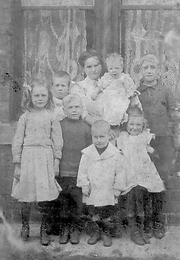 Donated by Mr. John Brooker
Donated by Mr. John BrookerThe Herbert family children outside their home at No.9 Portland Street, Longhill, West Hartlepool, taken sometime in the late 1890s or eraly 1900s. At the back is the eldest child Bella, holding baby Elizabeth and the tall boy next to her is Tommy, who was killed during the Frirst World War.
The names of the other children are Dot, Cilla, Danny (who later ran a newspaper kiosk in Church Street), Marshall and Derick.





